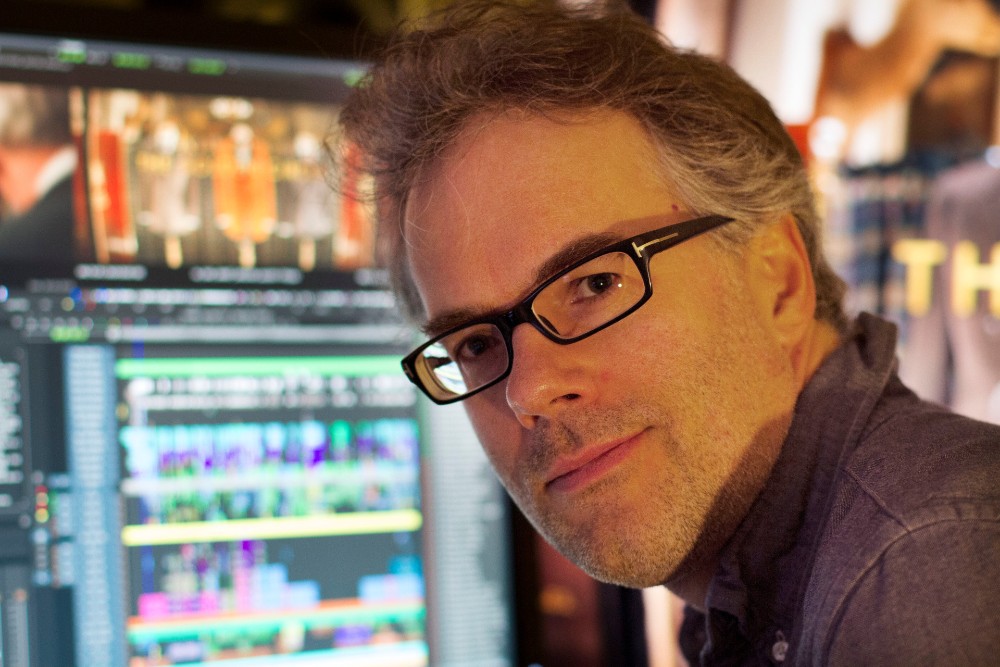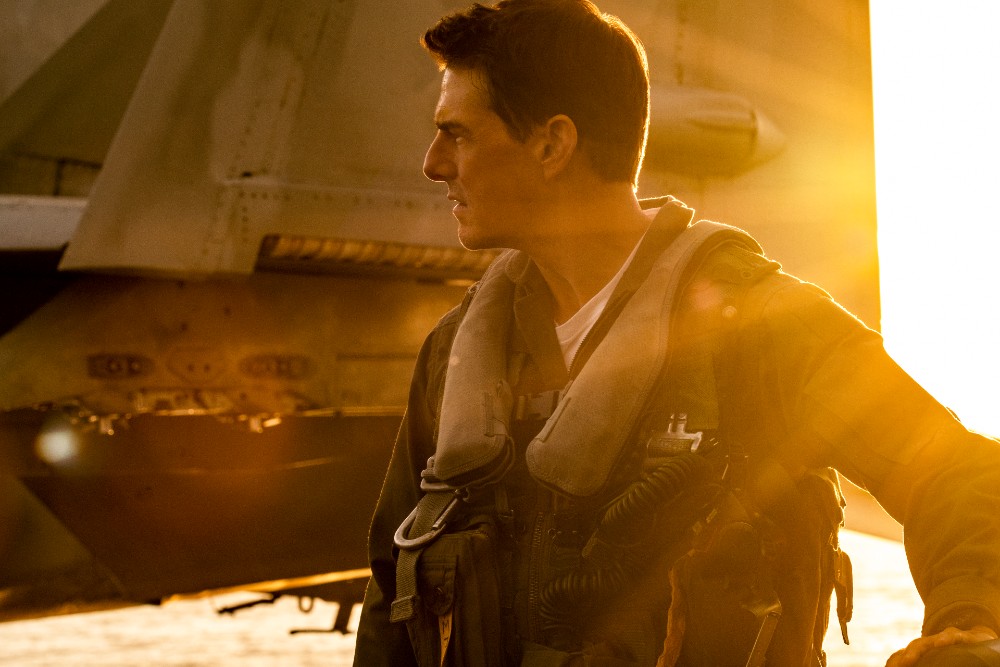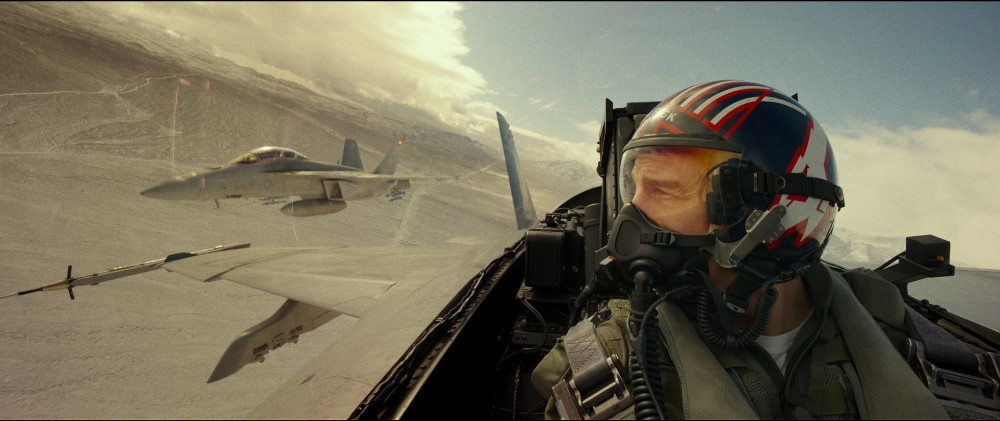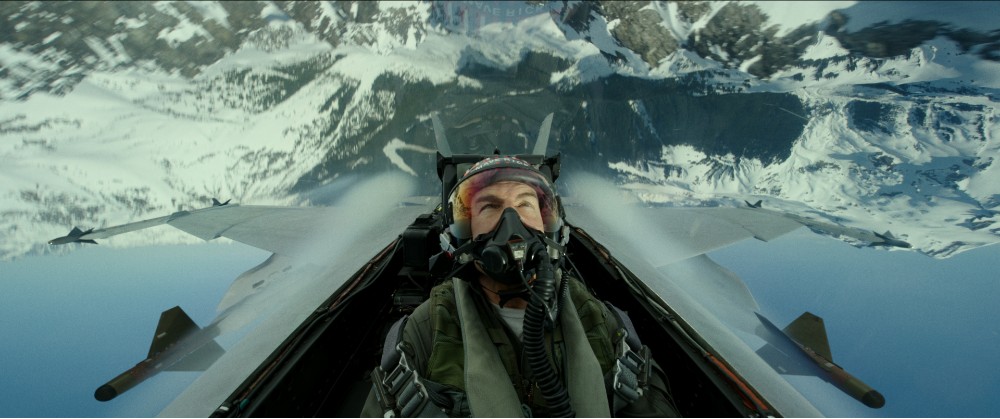In Hollywood, sometimes it’s not about what you know, but who you know, and Tom Cruise is a pretty good person to know, especially if you’re a Film Editor.
Such is the case with Eddie Hamilton, who knew Cruise from editing the fifth and sixth Mission: Impossible movies for Director Christopher McQuarrie. When Cruise was finally ready to make Top Gun: Maverick, the long-gestating sequel to the 1986 blockbuster that made him a global movie star in the first place, he recommended Hamilton to Director Joseph Kosinski because he knew that Maverick would be just as complicated and involved as those Mission sequels.
Before taking on the Mission: Impossible movies, Hamilton had been working with Director Matthew Vaughn, cutting a number of his action movies including Kick-Ass, which put him in a good position to handle the kind of quick-paced aerial action seen in the Top Gun sequel. Since finishing Maverick, Hamilton has been embroiled in cutting McQuarrie’s Mission: Impossible – Dead Reckoning, which is so big that it’s already been divided into two parts, which will be released this summer and next year.
Below the Line recently jumped on the phone with Hamilton to talk about what was involved in creating some of the most memorable moments in Top Gun: Maverick.

Below the Line: I was looking over your bio and your filmography, and you’ve been editing for about 25 years or so. I think the first movie you worked on that I’ve seen was Mean Machine, believe it or not.
Hamilton: [laughs] Yeah, there you go. Working with Matthew Vaughn as a producer.
BTL: What was your entry point into the world of editing? I’m always curious about the background of craftspeople, who tend to have interesting stories.
Hamilton: Okay, I’ll give you the potted summary. I was obsessed with movies from the age of eight, and I thought I’d be George Lucas or Steven Spielberg, like everyone does when they’re eight. And then I discovered by the age of 17 that storytelling and technology kind of worked for me, and that editing suited that combination. I tried to get into film school, failed to get in, and then ended up being a runner or a PA in central London at a post-production facility. This was in 1995 when Avid Media Composer was just starting.
I remember teaching myself how to use the software, and then, because I was very young and enthusiastic and ready to go, there was one day [when] an editor didn’t show up for a session with a client, and I just stuck my hand up and said, ‘I can do that.’ So I ended up being given a shot, but I was desperate to do movies. That was always my first love. My spiritual home was in a cinema watching a movie on a big screen.
I was reaching out to as many young filmmakers as I could in London at that time. I did several low-budget movies and some completely for free, and I’d support myself by editing promos for the Paramount comedy channel, like, three days a week, and then the other four days a week, I would work on films for free for people.
One of my biggest breaks was doing Mean Machine with Matthew Vaughn in 2001. I had a friend who knew a friend of his, and I heard that he was making this film, and I said, ‘Can you talk to your friend and just say, ‘Can I somehow meet Matthew Vaughn?” He was actually looking for two editors because he wanted two editors to edit that movie. He wanted to cut the film in half and give one editor the first half of the movie, and then another editor the second half of the movie. I ended up getting a chance to work with him on that. Actually, I’m still very good friends with him, and we talk quite often about films that he’s got coming up, so that was the first foot in the door of a larger world of movie-making [for me], certainly. [And] then [I went] on to Kick-Ass and X-Men: First Class. That was my [first] proper big studio movie.
BTL: Was Top Gun your first time working with Joseph Kosinski?
Hamilton: Yes, it was. It came about because of Tom Cruise. I’d done two Mission: Impossible movies with him, and we had a very good working relationship. He knows that I love movies as much as he does, and I bring that enthusiasm every day to the work that I do. He knows that I never phone it in, and I’m always super-thorough. I care about the end product as much as anybody, as much as Tom Cruise does, and so he said to Joseph Kosinski and Jerry Bruckheimer, ‘would you have a chat with Eddie about doing the film?’ Also, there’s this helicopter chase sequence at the end of Mission: Impossible – Fallout, which was 80 hours of footage for a nine-minute sequence. That enormous treasure hunt of breaking down all this footage, and then turning it slowly into this nearly 9-minute and 50-second [sequence], I think, in the finished movie. That kind of scale of raw material, and compressing it down… they knew that Top Gun was going to take that to the next level.
Listen, I did get quite overwhelmed by all the footage, because any single human would be. There was so much. It’s like a mountain to climb, and you just think you’ll never get to the top of it, to be honest. Like everything, you start putting one foot in front of the other and climbing up. I’m sure it’s the same whenever you’re writing a big feature — sometimes, it’s just so daunting, and you just have to start putting finger to keyboard and writing words, and then eventually you’re halfway there. It doesn’t matter if it’s terrible, you just have to get to the end of it, and then you can look at it and go, “How do I make it better?” That’s what editing is the whole time. Forcing yourself to get to the end, however bad it is, [because] then you’re going to refine it and refine it later.
But yes, it was my first time working with Joe Kosinski, and we actually had a great, really fun time working on the movie, because we’re the same age, and we love all the same movies. We would quite often look at each other and go, ‘Oh my God, can you believe what we’re doing? We’re here on a naval base with these F18s, filming this incredible movie.’

BTL: I want to go back a little, because you mentioned that when you started, Avid was coming into play, but did you actually do any editing on film? Did you learn how to do that as well?
Hamilton: I did. When I was a student, I did do a few student movies on film. But it is so difficult, compared to working with a digital editor. It’s so much harder to log footage and break it down and make changes and have different versions and all that stuff. Chris Lebenzon came on to help me with Top Gun for a bit. He worked on the original, and on Days of Thunder and Enemy of the State, and all of Tim Burton‘s movies since Batman Returns. I got to ask him all the questions about Days of Thunder and Top Gun… to edit those on film, it’s just monumentally difficult. Technology really does help us. I’m kind of glad those days are gone, to be honest.
BTL: I was reading this interview with Joe and Cinematographer Claudio Miranda, and they were talking about these two-hour meetings every day on the set of Top Gun, in which you were included. I know editors tend to get involved fairly early on and can even be working on set, but doing a two-hour meeting every day on set… is that a new thing for you?
Hamilton: Listen, it was more than two hours. I will tell you. It was seven until 9 a.m., and then the sortie would go up, and then they would land, and then we would watch the footage for an hour. Then there’d be another two-hour briefing in the afternoon. Then they would go up and they would film, and then there’d be another hour-long debrief. We were sitting for six hours a day in briefings and debriefing. It was a lot of time. It was Tom Cruise who said, ‘I want Eddie there,’ because he wanted me to understand what they were trying to get with every sortie. I would be there listening to them describe and listening to them rehearse, and then when they landed, I could really look at the footage and assess whether, in my opinion, we’ve got the emotional and dramatic and action beats that they were going for. It was quite useful because, by the end of it, I did have an encyclopedic knowledge of every sortie, because I’d broken everything down religiously. It didn’t give me much time to edit the film, that’s the problem. All I had time to do was go through the footage and break it down. But editing it had to wait until… I started building some stuff, but I really had to do it later, because also, it’s very hard to build a sequence with only a handful of shots when you need 200 shots. It’s actually easier sometimes to wait until you’ve got a lot more material in order to start building it.
BTL: I have a feeling you’ve been working on those movies for three years now, so I’m sure it’s something always on your mind. Because of COVID, I’ve forgotten when Maverick was supposed to be released. Was it Summer of 2020, and was it already finished by then?
Hamilton: It was supposed to come out [in] May 2020, but we actually finished the film at the end of July. We had a few extra months of time, which was invaluable, I will say. The hiatus of COVID, and the fact that, also, we weren’t in production on Dead Reckoning – Part One and trying to post-produce Top Gun at the same time. That would have been very, very difficult indeed. Because of the pandemic, we weren’t rolling cameras, and so the entire focus of the creative team went onto every single frame of Top Gun, from beginning to end, which is one of the reasons why I think the film turned out so well.

BTL: Do you usually work out of an editing house, or do you have a set-up that allows you to work wherever you are?
Hamilton: I do. There is so much working on location or on set or wherever. I work in cars, on planes, in helicopters, on boats — literally everywhere. On Top Gun, I was on aircraft carriers and naval bases and often in a plane traveling from one place to another. In the back of a car, I’d be working. But usually, what we’d do [is], we had a cutting room set up at Jerry Bruckheimer’s office in Santa Monica, and they were doing Bad Boys at the same time.
BTL: Now that I know what a “sortie” is, I want to go back to those meetings you’d have every day. The way you talk about the meetings makes them sound a little like the debriefings for the mission in Top Gun.
Hamilton: It was really similar.
BTL: As an editor, when it comes time to shoot some of the airplane sequences, what are some of your concerns, and what do you want to make sure they’re able to capture when they’re up in the air?
Hamilton: Well, it’s carefully rehearsed on the ground. Everybody is watching everyone else’s footage, so we’re all learning as we go because it’s never been done before. Tom did everything first because he said, ‘I never want to ask anyone to do anything that I haven’t done myself.’ Actually, one of the very first things we filmed was the second half of his canyon run sequence, where Maverick does the canyon run in 2:15.
So, not the stuff in the canyon — that was done a lot later — but it’s the stuff where he’s blasting over the desert very low, and he does the imaginary pop-up and dive down, and he’s targeting. All that stuff was done first because it’s very physically demanding. It’s very dangerous, as well, being in that low over the desert. He wanted to show the pilots that it was safe, and that it [could] be done, you [just] have to make sure the sun is over your shoulder. You have to make sure that your visor is clear, and that your sound and your cameras are running and all that stuff — do your own hair and makeup on the plane.
The cast would also write timecode notes of when they [did] certain maneuvers, so we [could] call them up and check them when they landed. We would get between 20-40 minutes for each flight of footage. The six cameras in the cockpit would start and stop at the same time, and then it was just a case of going through it and checking to see [that] we have the emotional beats we needed so [that] you felt what the characters needed to feel in the scene.
BTL: Are you able to monitor the footage on the ground while Tom’s up in the air, or do you always have to wait for his plane to land?
Hamilton: Yes, they would land, and we would take a card out of the camera, the wide center shot, and then we would load it into a playback device and run it immediately. Claudio would be grading live. They would add a LUT to the shot, and then he would be adjusting the exposure as we were watching it to make sure it looked right on the screen. And then, we would transcode it and load it into my Avid Media Composer as soon as possible afterward so I could start grouping all the cameras and breaking all the footage down with my team.
BTL: What kind of system do you have with you? Do you have multiple drives and back-ups and that sort of stuff?
Hamilton: Yeah, exactly. I have a 96-terabyte hard drive laptop, a MacBook Pro, and I had two monitors set up in a trailer at the Naval Base. I had a large TV, so the director or the producer could come in and watch. Actually, we recorded quite a lot of additional dialogue in that trailer as well, because sometimes the in-cockpit recordings weren’t quite clear enough because you’re just recording an aircraft radio transmission. [So], sometimes we’d get the actors to do the lines again on the ground with a microphone to make it super-clear, and I’d have those in my kit for later on.
We did rewrite the aerial lines dozens of times and rerecord them dozens of times to get the intonation and the story exactly right. We used to send microphones in the mail, which I know a lot of productions did, but [we’d] get microphones dropped off at their house and they would record their own ADR in their closets, and then they would send them to us on their phone. They would literally record on their phone and then send us the files, and then we would load them in. It was what we had to do.
BTL: Were there any reshoots once things reopened from COVID or were you already onto Mission: Impossible 7 at that time?
Hamilton: We had finished filming. We literally did our last few bits of additional photography maybe a month before COVID, so we didn’t need any more photography. We were still working on music, so all the music was recorded in lockdown, some of the dialogue was recorded, all the sound mixing was done. We were the first film back in the sound mixing studio after lockdown lifted. We were back in June 2020, so everything had shut down for about three months, and then we were one of the first films back in.
BTL: Do you remember what the longest assembly was for the movie? I know sometimes a movie can end up three hours or longer and then you have to edit it down to something that’s considered more reasonable by the studio. But some directors are quite frugal about overshooting footage that won’t end up being used.
Hamilton: That’s interesting. To be honest, I think the longest assembly was maybe 2:45, so we compressed it by about half an hour, which is about right… about average. A lot of the aerial sequences started out much longer, because that’s just the process, and then they ended up being compressed down. I think we got it down to, like, 2:11 with credits, by the time we finished.

BTL: Obviously, editing plays such an important part in action movies, but there are also some really heartbreaking scenes, like the one between Maverick and Val Kilmer’s Iceman. What was involved with putting those scenes together?
Hamilton: Every frame of every scene, I swear, we poured our heart and soul into making sure that the scenes flowed. You’re subjectively in Maverick’s point of view from the beginning, [and] almost entirely through the running time of the film. Apart from the scene with maybe Rooster and Phoenix on the tarmac after the first dogfight, you’re pretty much with Maverick all the way through the movie. It’s very important that you are subjectively tracking the emotion of that character because it’s what allows you to feel engaged and connect with the story from beginning to end.
We spent hours and hours crafting every scene, and the Iceman scene… obviously, everyone’s waiting for that scene. If you’re a fan of the original, you’re like, “When is this gonna happen?” It had to deliver. We really took our time to make sure that all the emotions landed exactly right for the audience, and then have a little humorous moment between the two of them — “who’s the better pilot?” — as a way of lightening the mood at the end of the scene so it wasn’t quite so downbeat.
BTL: Even though they were trying to do as much practically as possible, there’s always VFX involved. At what point is the VFX Supe involved, where you’re creating the pipeline with that team?
Hamilton: We’re working very closely. A lot of the [fighter jets] in the movie are CG. There are no F14s that fly anywhere in the world, and there are no Su57s, so that whole dogfight at the end is using F18s and L39s, and then the jets are reskinned with visual effects, flawlessly, to feel like an F14 or Su57. Every interior shot of Maverick and Rooster at the end is shot in an F18, so they have to change the cockpit to look like an F14. All [that] stuff is done totally invisibly, and you think, “God, that’s hundreds of shots they must have done,” and it literally is hundreds of shots. Wherever it was too dangerous to have Maverick flying between jets and stuff, we would film it in two passes and composite [it] together. And then, obviously, the Dark Star isn’t a real thing that flies at the beginning. All of that is CG — that whole opening sequence where he’s skimming around the curvature of the earth.
BTL: Are you getting some sort of pre-vis to work from in the editing process?
Hamilton: Yeah, sometimes. For Dark Star, we did have quite a bit of pre-vis. For the dogfights, it was more difficult because you can’t actually predict what footage you’re going to get when an F18 is going 700 miles an hour on a long lens. You just get what you get from the camera platforms — from the helis and the other jets and the ground cameras. That’s part of the fun though. It’s what gives the film a very tactile, immediate feel — because it’s not over-choreographed. You are literally having to cut the scenes together with what footage you managed to actually get on the day. It is a very unique jigsaw puzzle in that respect.
BTL: It’s been great talking to you. I hope we’ll have a chance to talk more about the new Mission: Impossible movies once they come out. I know you’ve been working hard for three years on those…
Hamilton: It will be four years in total for two of them. It is nuts to be in production and post-production at the same time — it’s very difficult. I get a sense of what they were doing on Infinity War and Endgame and when they did those two Harry Potters — Deathly Hallows, Part One and Two. That was one editor doing both [of] those movies as well, so I’m really getting a taste of what they went through on those.
Top Gun: Maverick is now streaming on Paramount+ and available to buy or rent on all major digital/VOD platforms.





